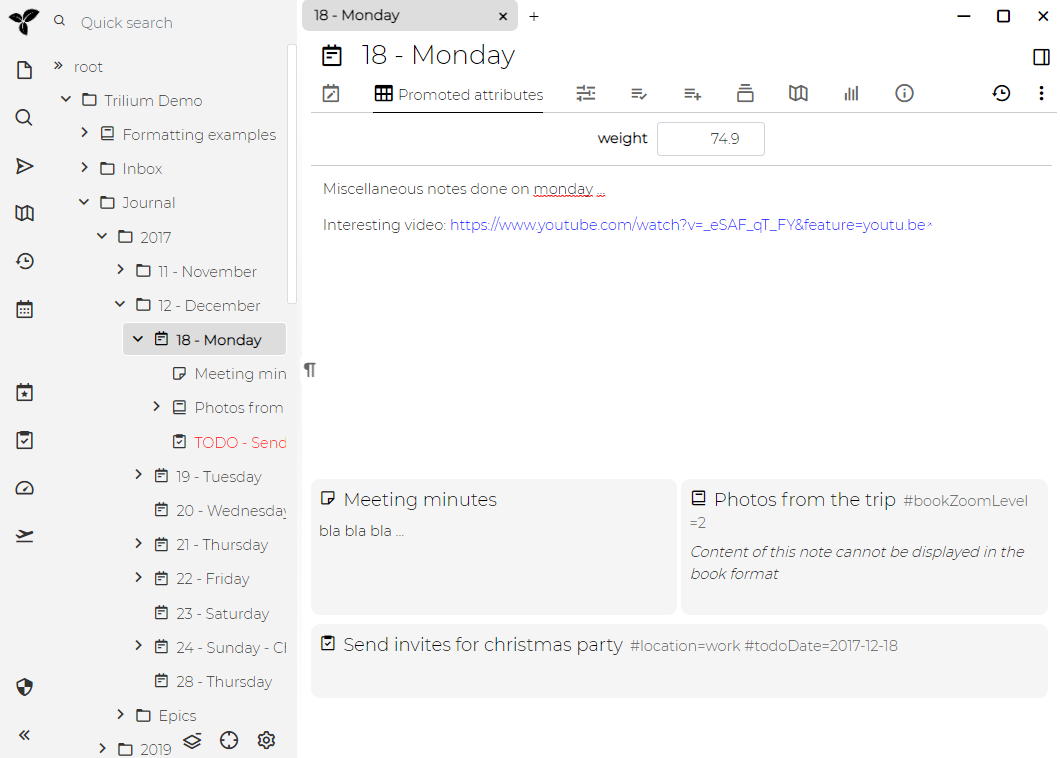Docs
Day-notes
A common pattern in note-taking is that a lot of notes will be centered around a certain date - e.g. you have some tasks which needs to be done on a certain date, you have meeting minutes from a certain date, you have your thoughts etc. and it all revolves around a date on which they occurred. For this reason, it makes sense to create a certain “day workspace” which will centralize all those notes relevant for a certain date.
For this, Trilium provides a concept of “day note”. Trilium semi-automatically generates a single note for each day. Under this note you can save all those relevant notes.
Select an existing day note, and the menubar contains a calendar widget. Select any day to create a note for that day. 
| This pattern works well also because of [[cloning | Cloning notes]] functionality - note can appear in multiple places in the note tree, so besides appearing under day note, it can also be categorized into other notes. |
Demo

You can see the structure of day notes appearing under “Journal” note - there’s a note for the whole year 2017, under it, you have “12 - December” which then contains “18 - Monday”. This is our “day note” which contains some text in its content and also has some child notes (some of them are from Task manager).
You can also notice how this day note has promoted attribute “weight” where you can track your daily weight. This data is then used in Weight tracker.
Templates
Trilium provides template functionality, and it could be used together with day notes.
You can define one of the following relations on the root of the journal (identified by #calendarRoot label):
- yearTemplate
- monthTemplate
- dateTemplate
All of these are relations. When Trilium creates a new note for year or month or date, it will take a look at the root and attach a corresponding ~template relation to the newly created role. Using this, you can e.g. create your daily template with e.g. checkboxes for daily routine etc.
Date pattern
It’s possible to customize the title of generated date notes by defining a #datePattern label on a root calendar note (identified by #calendarRoot label). Following are possible values:
{dayInMonthPadded} - {weekDay}day notes are named e.g. “24 - Monday”{dayInMonthPadded}: {weekDay3}day notes are named e.g. “24: Mon”{dayInMonthPadded}: {weekDay2}day notes are named e.g. “24: Mo”{isoDate} - {weekDay}day notes are named e.g. “2020-12-24 - Monday”{ordinal}is replaced with the ordinal date (e.g. 1st, 2nd, 3rd) etc.
Month pattern
It is also possible to customize the title of generated month notes through the #monthPattern attribute, much like #datePattern. The options are:
{monthNumberPadded}results in a number like09for September, and11for November{month}results in the full month name (e.g.SeptemberorOctober){shortMonth3}is replaced with the first 3 letters of the month, e.g. Jan, Feb, etc.{shortMonth4}is replaced with the first 4 letters of the month, e.g. Sept, Octo, etc.
The default is {monthNumberPadded} - {month}
Implementation
Trilium has some special support for day notes in the form of backend Script API - see e.g. getDayNote() function.
Day (and year, month) notes are created with a label - e.g. #dateNote="2018-08-16" this can then be used by other scripts to add new notes to day note etc.
Journal also has relation child:child:child:template=Day template (see [[attribute inheritance]]) which effectively adds [[template]] to day notes (grand-grand-grand children of Journal).